
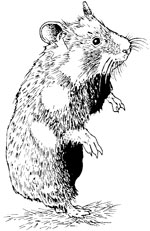 Golden Hamster: The Syrian Hamster or Golden Hamster, Mesocricetus auratus, is the best known member of the rodent subfamily Cricetinae, the hamsters. They may now be extinct in the wild, but are popular as house pets all across the world, and are also used in scientific research. Adults grow from 12.5 to 17.5 cm (5 to 7 inches) in length, and in captivity will usually live from 2 to 3 years. Golden Hamster: The Syrian Hamster or Golden Hamster, Mesocricetus auratus, is the best known member of the rodent subfamily Cricetinae, the hamsters. They may now be extinct in the wild, but are popular as house pets all across the world, and are also used in scientific research. Adults grow from 12.5 to 17.5 cm (5 to 7 inches) in length, and in captivity will usually live from 2 to 3 years.
Cheek Pouches: Like most members of the subfamily, the Golden Hamster has expandable cheek pouches, which reach from its cheeks to its shoulders. In the wild, hamsters are larder hoarders, and they use their cheek pouches to transport food to their burrows.
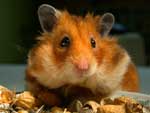 Built in Storage: They can load a remarkable amount of food into their pouches; their name in the local Arabic dialect in the area where they are found translates as "father of saddlebags." If food is plentiful, they will store it in large amounts, and it has been reported that 25 kg of grain was found in the burrow of a single hamster. They are notoriously good at reproducing, with the shortest gestation period of Built in Storage: They can load a remarkable amount of food into their pouches; their name in the local Arabic dialect in the area where they are found translates as "father of saddlebags." If food is plentiful, they will store it in large amounts, and it has been reported that 25 kg of grain was found in the burrow of a single hamster. They are notoriously good at reproducing, with the shortest gestation period of
any mammal.
Coat of Many Colors: Most hamsters in American and British pet stores are Syrian Hamsters. Originally, Syrian Hamsters came in just one color — the mixture of brown, black, and gold which gave them their "Golden" name — but they have since developed a myriad of color mutations such as cream, white, blonde, banded, tortoiseshell, calico, and sable. Therefore in pet stores today, Golden Hamster is only used to label the original coloration (also known as "agouti), while the other-colored short-hairs are banded under the label Fancy Hamster.
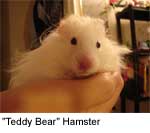 Teddy Bear: Teddy Bear is a term used to describe the long-haired variety of the Syrian Hamster, named so for their remarkable resemblance to toy teddy bears. They are also sometimes known as "angora hamsters". Male teddy bear hamsters usually have much longer fur than the female variety, culminating in a "skirt" of longer fur around their backsides. Teddy Bear: Teddy Bear is a term used to describe the long-haired variety of the Syrian Hamster, named so for their remarkable resemblance to toy teddy bears. They are also sometimes known as "angora hamsters". Male teddy bear hamsters usually have much longer fur than the female variety, culminating in a "skirt" of longer fur around their backsides.
Black Bears: Black Bears are a recent off-shoot of teddy bear hamsters (mutation discovered in 1985), with their major difference being their black-colored fur. It can be argued that black bears are just black teddy bears rather than their own breed; on the other hand, originally black bears were selectively bred for their larger size and more docile nature as well as their color, however in current stock, this may or may not still be the case.
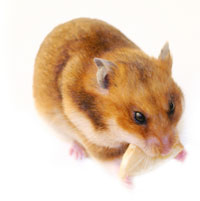 Wildly Popular: Syrian Hamsters are wildly popular as housepets due to their docile, inquisitive natures and small size. Wildly Popular: Syrian Hamsters are wildly popular as housepets due to their docile, inquisitive natures and small size.
They are popular as "first pets" for young children, as well as being classroom animals, because of their hardiness and relative ease of care. Some pet owners find them more attractive in relation to rats and other rodents due to their lack of visible tails.
No Roommates, Please: When kept as pets, however, Syrians must be housed, past the age of around 10 weeks, on their own. Syrian hamsters are notoriously territorial, and will frequently attack and, indeed, kill, other adult hamsters of the same sex.
Scientific Research: Syrian Hamsters have also been used in scientific research — in the study of many diseases, as well as in the study of behavior. They have a number of fixed action patterns that are readily observed, including scent-marking. They are particularly used in airway and respiratory physiology research.
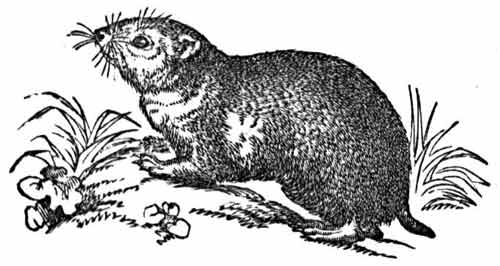
All text is available under the terms
of the GNU Free Documentation License
|